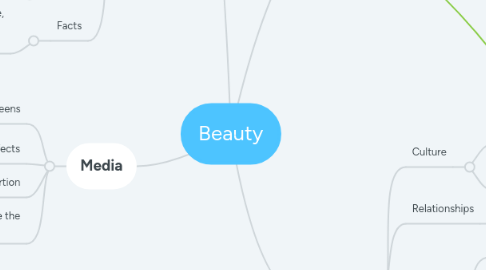
1. Media
1.1. Teens
1.1.1. Most affected by media and people´s opinions
1.2. Effects
1.3. Distortion
1.3.1. Distortion of way of we see
1.4. Movies and TV also help change the beauty standard over the time.
2. Body Image
2.1. The way you see yourself (Perceptual)
2.2. The way you feel about the way you look (Affective)
2.3. The thoughts and beliefs you feel about your body (Cognitive)
2.4. The things you do in relation to the way you look (Behavioural)
2.5. The thoughts and beliefs you feel about your body (Cognitive)
2.6. Main influences
2.6.1. Social Media
2.6.2. Ability or disability
2.6.3. Family environment
2.6.4. Puberty
2.6.5. Cultural background
3. Health
3.1. Mental Health
3.1.1. The unrealistic ideal of beauty can cause for those who try to achieve it the detrimental of their mental health.
3.1.1.1. Anxiety
3.1.1.2. Depression
3.1.1.3. Low self-esteem
3.2. Physical Health
3.2.1. Disorders
3.2.1.1. Anorexia
3.2.1.2. Bulimia
3.3. Statistics
3.3.1. Weight
3.3.1.1. Ideal weight is variable by height.
3.3.2. Height
3.3.2.1. Ideal height for woman: 5´6; Ideal height for men: 5´11
3.3.3. Age
3.3.3.1. Usually, the ideal is for young people (16-40 years old)
3.4. Issues
3.4.1. Health care
3.5. Facts
3.5.1. Magazines with diet, workout, skincare, healthcare tips (some can be fake or unhealthy)
4. History
4.1. Ideal
4.1.1. How has the concept of beauty changed over time?
4.1.1.1. The concept of beauty is constantly changing. It changes based on art, social construction, fashion, technology and politics. There have always been norms for beauty, in Ancient Egypt the beauty was symmetrical and slim silhouettes. And young women were considered the most beautiful. In Ancient China, beauty was all about being small. Women strived for tiny waists and feet, long hair and very pale skin.
4.2. Fashion
4.2.1. Divided into different aesthetics
4.2.2. Models
4.2.2.1. Mostly skinny and white; lack of representativeness
4.2.2.2. Magazines, and advertising also help change the beauty standard over the time.
4.3. Society
4.3.1. Perception
4.3.1.1. Female
4.3.1.2. Male
5. Self
5.1. Culture
5.1.1. Global
5.1.2. The ideal of beauty change from each culture.
5.2. Relationships
5.2.1. Communication
5.3. Money
5.3.1. Diet industry
5.3.1.1. Use of unhealthy ways to lose weight
5.3.2. Cosmetic surgery
5.3.3. Fashion
5.4. Therapy
5.4.1. Search for psychologists has increased 93,8% in 5 years (2014-2019).
5.4.2. Search for psychiatrists has increased 44,5% in 5 years (2014-2019).
5.4.3. Search for occupational therapy has increased 137,8% in 5 years (2014-2019).
